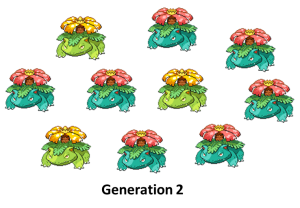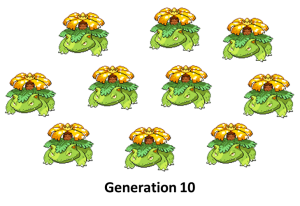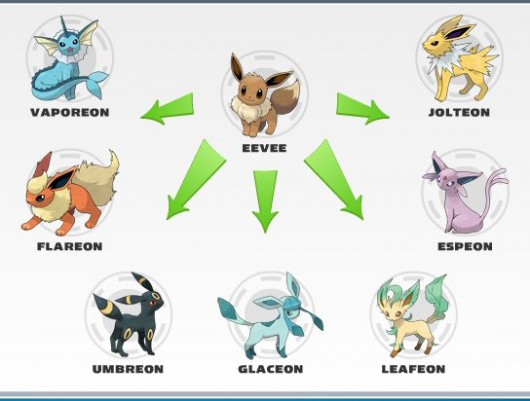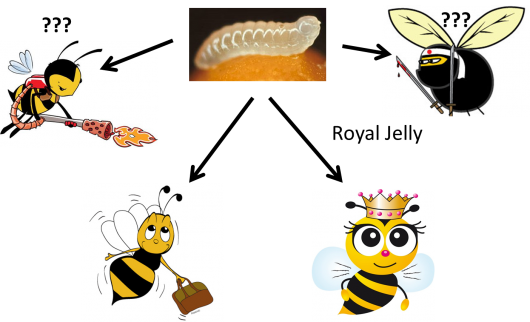(Click here for the introductory post to Pokébiology 101)
You know I had to start my Pokébiology 101 series with the most famously scientifically inaccurate part of Pokémon: evolution.
In the Pokémon world, “evolution” means something different from what you might have learned in your biology classes. …Well, what you should have learned in your biology classes, assuming the religious right failed to push their agenda into your science classroom. Pokémon evolution is when a Pokémon transforms into a different looking creature once some criterion is met. Most often this means reaching a certain level (levels increase as you gain experience, experience comes from participating in battles). Some Pokémon evolve under weirder circumstances like being exposed to a particular item, being traded to another player, reaching a certain level of happiness, and so on.
For example, a Bulbasaur evolves into an Ivysaur at level 16, and an Ivysaur evolves into a Venusaur at level 32.
This is not evolution. This is metamorphosis.
What’s the difference? Why are Pokémon actually metamorphosing, and not evolving? They both imply some sort of change is taking place, which is why the terms are so easily confused. But there’s a major difference in when and where that change happens:
- Metamorphosis is the change in body structure of an individual that happens conspicuously and abruptly during their lifetime. The most common real world example is a caterpillar turning into a butterfly. This is exactly what happens in the Pokémon world. Well, instead of forming a cocoon, Pokémon flash a bright light and make cheery beeping noises…but I’m going to chalk that up to the games being from the point of view of a ten year old with an overactive imagination. Wee, shiny!
- Evolution is the change in heritable characteristics of a population over successive generations. A characteristic is heritable if it is genetic, and thus will get passed on from parent to offspring, and from that offspring to its offspring, and so on. The key here is that this change happens over many generations and affects the whole population.
What would be a hypothetical example of actual evolution in the Pokémon world? Let’s say we’ve stumbled upon a population of Venusaurs in some jungle untouched by Pokémon trainers. Most Venusaurs have pink flowers, but a rare individual has a gold flower because of a mutation. In case you’re wondering, this alternative color scheme exists in-game and is known as a “shiny,” and shiny Pokémon are incredibly rare. Like, “I’ve probably played 1000 cumulative hours of Pokémon games and I only found one shiny Sentret a decade ago” rare.
Now, let’s say that shiny Venusaur is very successful in producing a lot of baby Bulbasaurs for whatever reason. Maybe gold flowers attract more prey, so shiny Venusaur is well fed and can have more babies (directional selection). Maybe other Venusaurs find the rare gold flower extra sexy, so shiny Venusaur has more mates and thus more babies (sexual selection). Maybe it’s all due to random chance and shiny Venusaur just gets lucky (genetic drift). When that generation of Bulbasaurs grows up, the new generation of Venusaurs might look something like this:
If we’re still around to observe this population many generations later, it may look like this:
The shiny trait has now become “fixed” in the population – that is, every individual now has the gold flower. Now the population of Venusaurs looks different than it used to – and that is evolution! If this population is isolated from other Venusaurs and continues to evolve novel traits, one day this population might be so different that it can’t even mate with other Venusaurs anymore. And that, folks, is when you have a new species.
But back to metamorphosis. The common caterpillar example is linear: a caterpillar makes a cocoon and becomes a butterfly. But not all Pokémon have a set fate. I give you the most enigmatic example, Eevee.
Eevee is special in the world of Pokémon because it has the largest number of ways it can evolve depending on your actions. Want a Flareon? Give Eevee a Fire Stone. Espeon? Make Eevee very happy and level up during the morning or day. Leafeon? Level up while near a mossy rock.
It seems like this couldn’t possibly exist within the confines of our natural world, right? How does an Eevee have the ability to metamorphose into such different creatures just from what its exposed to in the environment? How can a Vaporeon, Jolteon, Flareon, Espeon, Umbreon, Glaceon, and Leafeon all have the same genome as their starting Eevee, but such different traits?
Not to erode Eevee’s specialness, but this happens right here on Earth.
This is known as polyphenism: when multiple discrete phenotypes (a set of observable characteristics) can come from the same genetic background because of differences in the environment. The most common example is different castes in bees. You may know that within a hive, one female gets to be the queen bee, and the other females are worker bees. A queen bee is made by feeding a larvae what’s known as “royal jelly,” which contains chemicals that alter the larvae’s development. If that larvae has a twin sister that didn’t get a special meal, sis will grow up to be a worker. They’re genetically identical, but very different thanks to their environment.
The only thing distinguishing bees from Eevees are the number of choices in development.
In which I speculate on what would happen if you gave a bee a Fire Stone or Macho Brace.
It will forever irritate me that the game designers chose the term “evolution” instead of a totally accurate, also cool-sounding alternative word. My best guess is that “Bulbasaur is metamorphosing” took up too many pixels, so “evolving” won out. Sadly, this kind of sloppy terminology can cause a lot of misconceptions about what evolution really means. But hopefully now that you’ve learned some Pokébiology, you’re less confused.
So confused.









The article was amazing, don’t get me wrong, but that picture at the end is possibly the greatest thing humanity has ever produced.
I wonder if something could have been lost in translation with the fact that “evolution” used to mean a development (from the latin “evolvere” which meant to “unfold” or “unroll”) rather than the branching population-level phenomena we define evolution as being today. I have no idea how any of this translates to Japanese though so I can only offer up the possibility of something going on here.
Devil’s advocate — is it possible that Pokémon creatures are not simple metazoic organisms, but actually enormous colonies of bacteria (or bacteria-like entities) with hive minds? In which case the metamorphosis might actually be due to evolution, once some critical mass of the population shares some novel mutation?
Or is this already ruled out by other known information about Pokébiology?
There is an example of real evolution (or speciation) in Pokémon: Shellos and Gastrodon.,They are found in two seas separated by the main mountain range in Sinnoh, and look different depending on where they were caught. From Bulbapedia:
Some Pokemanz totally use cocoons.
The Japanese Pokemon games use the word 進化 which means either evolution or progress. So maybe the Pokemon are really progressing.
Where were you when my kids were ten? You explained this so much better than I did at the time…
I agree with cowtown, in that the underlying problem is one of translation.
This claim is completely false. We population geneticists acknowledge that natural selection has been occurring on humans for some time, and has left traceable signatures in the genome to identify such events. Notable examples include LCT (lactase), ABO (blood group antigens), and SLC24A5 (skin pigmentation), among others. Your claim about what ‘science minded leftists’ believe is pure fantasy.
Because ‘smart leftists’ know that you are way, way misinformed. We’ve known in population genetics for over a decade now that genetic differences within populations are greater than any genetic differences between populations. That means that yes, much of between-population variability is due to a complex mixture of genetics and environment. Check out this paper if you don’t believe me:
http://www.ncbi.nlm.nih.gov/pubmed/12493913
Your comparison to the wolves, however, is flawed from the start. Directional selection is NOT the same as ‘regular’ evolution. Selection coefficients are WAY higher and drift has less of a role.
It’s pretty clear to me you have no idea what you’re talking about. In the era of genomics, we’ve sequenced people from almost every corner of the globe, and have yet to find a person whose genome is less than 99.9% identical to every other human on the planet. I know because that’s what I work on.
It pains me when people like you twist what I do to fit your own twisted, racist fantasies. Don’t use my science to justify your fever dreams.
Adamgordon- Man, peeps like you are bringing the pain lately. I love it! A savage, savage burn constructed from facts and sealed with righteous fury. Take that, Dogs! TssssSSSSSsss!!!!
Great to have you back. Awesome article.
@RunningDogs – Dear Mrs Troll (or Mr Troll), many things contribute to the development of a human being, some of those things are environmental, some are inherited. The “leftist evolution deniers” would say that the way to investigate different aspects of development would be to use science and not simply decide based on racial stereotypes.
I love a good pokemon breeding binge, and I would love if they threw up more “genetic” variation in future versions.
Gyrachu anyone? :D
Some 12 or so years ago, my kids were watching the Pokemon TV series and a character said, “there are 147 known species of Pokemon, but no one knows how many there really are.”
I like that line because it points out that we are always discovering new species, but my first thought was that there will always be new Pokemon species, as long as people keep buying the products.
What about that last part, I’ve always said given the lack of non-pokemon fauna in the pokemon world are humans not also pokemon (and thus catchable/enslavable)? Also a discussion about the oddity that geographically separated areas have rather undifferentiated species. Most likely due to humans introducing invasive species to such an extent that the entire globe contains only a few hundred species (less if you use the concept of metamorphosis to reduce the count) maybe even less considering many “species” can interbreed.
(Why can I log in with *YAHOO* but not Twitter?! O.o)
Anyway, someone above already covered 進化(shinka) =evolution/progress, but there’s one other aspect.
Tajiri Satoshi was, as a child, an avid bug collector, and the original inspiration for Pokemon was a bug collecting game for kids who grew up in cities and thus couldn’t bug collect as easily as country kids like himself.
For reason’s of broadening the appeal, it was changed into a “monster” collecting game and had a RPG story added, but at it’s core, it’s about collecting “monsters” (insects) who occasionally “progress” in a metamorphosis-like fashion.
(Also, in the earlier generations especially, bug types are disproportionally common and, in their advantage against psychic types, useful.)
I suggest, in the spirit of the revitalized Blag Hag, that we ignore RunningDogs. Xe is clearly here do derail this otherwise awesome thread into a discussion about hir own fantasy ‘libertarian’ world, as evidenced by the other thread.
RunningDogs, what you’re presenting here are common misinterpretations of human population genetics that are almost always used to justify racist beliefs. This is far from the first time I’ve dealt with this kind of crap before.
If you have a legitimate interest in human population genetics, I suggest you start reading some of the actual science instead of the crap you’re clearly getting fed from whatever liberturd website spewed you out.
This entry-level text is a good place to start:
http://amzn.com/0815341857
As for everyone else…please ignore RunningDogs, lest we all get fleas.
Great article. Sadly, the religious right did succeed in blocking my high school biology teachers from teaching me evolution. Luckily, I educated myself, but that means I still get get things wrong from time to time.
@ adamgordon: That was excellent as well. Thanks.
Please remember to stay on topic. Any comments that were off topic have been removed, and attempts to derail threads will be met with banning. Please don’t engage people who aren’t following the comment rules. Thank you.
Yay!!!!!
(I also thought about how West Sea and East Sea Shellos would fit into this, simply because we happen to have a West Sea Shellos plushie in the house. :) )
This series is so awesome. I wish I’d had it when I was playing Pokemon (perhaps I should pick it up again?). Also, as someone raised in an anti-science household, and bought that whole mentality I never paid any attention in my science classes. So I’m learning science a wee bit late- but learning none the less. Thanks!
Even covering territory I’m familiar with, this was a beautiful and fun read; it does a lovely job putting evolution in terms a lot more people might understand better.
While not nearly as thought-provoking, my own “Pokemon Biology” has always been the most popular article on my site. It could definitely use an update – I’m a much better writer and more experienced with science than I was almost ten years ago – but I’m still fond of it, ugly font colors and all!
It should come up on google under “I choose you, Rafflesia arnoldi!” – basically just a run-down of my favorite plants and animals to have inspired specific pokemon.
My favorite Pokebiology stuff is how they have realistic things that actually exist in the world.
Cute little Paras :3 Little buggie with mushrooms on its head… Wait… wtf… those mushrooms are draining the buggie’s life?! Paras is a host!?! Its evol… metamorphized version Parasect is when the mushroom has fully taken over its body?! OMG THERE’S A REAL LIFE FUNGUS THAT DOES THIS?!
Do not want!! *curls up into the fetal position*
Long-time lurker, first-time poster here. A few people have already jumped in to comment that the word used to describe the process in the original Japanese is 進化 (shinka; ‘evolution’ or ‘progress’). While it’s possible that they intended it in a more laic sense (as seen in things like 進化を遂げる, shinka o togeru, ‘to make [lit. achieve] progress’), my sense as a non-native speaker is that the scientific usage has colored the word to such an extent that I find it vanishingly likely they intended to exclude any allusion to the concept of evolution.
No, I suspect the reason they chose ‘evolution’ over ‘metamorphosis’ is that in Japanese, the word for the scientific concept of metamorphosis is 変態, ‘hentai.’
Yes, THAT ‘hentai.’ It’s written the exact same way as the colloquial term meaning ‘perverted’ or ‘pornographic.’ If you go to the English Wikipedia page for ‘metamorphosis’ and click the link at the side to surf to the Japanese equivalent, there’s even a disambiguation notice at the head of the article. I suspect the choice of 進化 over 変態 has less to do with ignorance of science and more to do with not wanting to include sentences that would say stuff like “Congratulations! Bulbasaur has done the hentai into Ivysaur!”* Straightforward taboo avoidance, in other words.
*Words like 進化 and 変態 become verbs by adding する, ‘to do,’ so yes, this is exactly how it would sound in a literal (Engrishy) rendering.
I’m not a biologist but I’m always willing to learn things, I’m afraid I don’t have anything constructive to offer apart from appreciation that you’re doing this series of fun-at-heart posts which have a real point to them. Thanks, Jen!
OK so it took a Pokémon related idea to make me start commenting on FtB. Hi Jen, I like your blog.
I am curious to see what, if anything, you’ll make of Deerling’s four different forms, which depend on the season during which it was caught. An individual Deerling doesn’t change with the seasons, but stays in the same form forever. How might that work? Also, is the Pokerus virus similar to anything that happens in real life? Can’t wait for the next post in this series.
By the way, the chance of encountering a shiny pokémon is 1 in 8192. I currently have five of those (Geodude, Ditto, Gyarados, Grumpig, Kyogre). This is what I did with my life.
Thank you so much for writing this!
Thanks Jen, this is great!
Looking forward to next class!
~Chris
I’m way late on this, but “morphing” and “evolving” have the same number of characters.